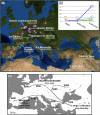Direct dating reveals the early history of opium poppy in western Europe
- PMID: 33219318
- PMCID: PMC7679390
- DOI: 10.1038/s41598-020-76924-3
Direct dating reveals the early history of opium poppy in western Europe
Abstract
This paper aims to define the first chrono-cultural framework on the domestication and early diffusion of the opium poppy using small-sized botanical remains from archaeological sites, opening the way to directly date minute short-lived botanical samples. We produced the initial set of radiocarbon dates directly from the opium poppy remains of eleven Neolithic sites (5900-3500 cal BCE) in the central and western Mediterranean, northwestern temperate Europe, and the western Alps. When possible, we also dated the macrobotanical remains originating from the same sediment sample. In total, 22 samples were taken into account, including 12 dates directly obtained from opium poppy remains. The radiocarbon chronology ranges from 5622 to 4050 cal BCE. The results show that opium poppy is present from at least the middle of the sixth millennium in the Mediterranean, where it possibly grew naturally and was cultivated by pioneer Neolithic communities. Its dispersal outside of its native area was early, being found west of the Rhine in 5300-5200 cal BCE. It was introduced to the western Alps around 5000-4800 cal BCE, becoming widespread from the second half of the fifth millennium. This research evidences different rhythms in the introduction of opium poppy in western Europe.
Conflict of interest statement
The authors declare no competing interests.
Figures



References
-
- Chouvy P-A. Opium: Uncovering the Politics of the Poppy. Cambridge: Harvard University Press; 2010.
-
- Salavert A, Martin L, Antolín F, Zazzo A. The opium poppy in Europe: Exploring its origin and dispersal during the Neolithic. Antiquity. 2018;92(364):e1. doi: 10.15184/aqy.2018.154. - DOI
-
- Candolle, A.-P. : D. Flore francaise ou Descriptions succinctes de toutes les plantes qui croissent naturellement en France, disposees selon une nouvelle methode d’analyse, et precedees par un expose des principes elementaires de la botanique. vol. Tome 5 (Desray, 1815).
-
- Hammer K, Fritsch R. The question of ancestral species of cultivated poppy (Papaver somniferum L.) Die Kultupflanze. 1977;25:113–124. doi: 10.1007/BF02014808. - DOI
-
- Ziegler J, Diaz-Chávez ML, Kramell R, Ammer C, Kutchan TM. Comparative macroarray analysis of morphine containing Papaver somniferum and eight morphine free Papaver species identifies an O-methyltransferase involved in benzylisoquinoline biosynthesis. Planta. 2005;222:458–471. doi: 10.1007/s00425-005-1550-4. - DOI - PubMed
Publication types
LinkOut - more resources
Full Text Sources

